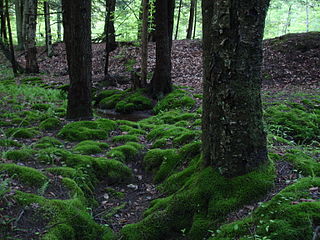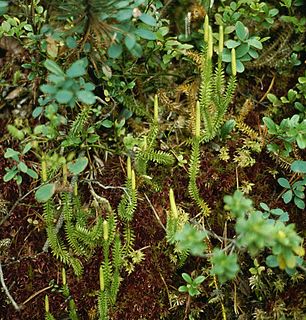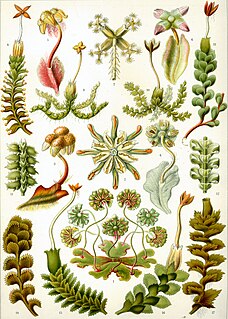
Mosses, or the taxonomic division Bryophyta, are small, non-vascular flowerless plants that typically form dense green clumps or mats, often in damp or shady locations. The individual plants are usually composed of simple leaves that are generally only one cell thick, attached to a stem that may be branched or unbranched and has only a limited role in conducting water and nutrients. Although some species have conducting tissues, these are generally poorly developed and structurally different from similar tissue found in vascular plants. Mosses do not have seeds and after fertilisation develop sporophytes with unbranched stalks topped with single capsules containing spores. They are typically 0.2–10 cm (0.1–3.9 in) tall, though some species are much larger. Dawsonia, the tallest moss in the world, can grow to 50 cm (20 in) in height.

Huperzia is a genus of lycophyte plants, sometimes known as the firmosses or fir clubmosses; the Flora of North America calls them gemma fir-mosses. This genus was originally included in the related genus Lycopodium, from which it differs in having undifferentiated sporangial leaves, and the sporangia not formed into apical cones. The common name firmoss, used for some of the north temperate species, refers to their superficial resemblance to branches of fir (Abies), a conifer. As of 2020, two very different circumscriptions of the genus were in use. In the Pteridophyte Phylogeny Group classification of 2016, Huperzia is one of three genera in the subfamily Huperzioideae of the family Lycopodiaceae. Most species in the subfamily are placed in the genus Phlegmariurus. Huperzia is left with about 25 species, although not all have been formally transferred to other genera. Other sources recognize only Huperzia, which then has about 340 species.

The Lycopodiaceae are an old family of vascular plants, including all of the core clubmosses, comprising 16 accepted genera and about 400 known species. This family originated about 380 million years ago in the early Devonian, though the diversity within the family has been much more recent. "Wolf foot" is another common name for this family due to the resemblance of either the roots or branch tips to a wolf's paw.

The Marchantiophyta are a division of non-vascular land plants commonly referred to as hepatics or liverworts. Like mosses and hornworts, they have a gametophyte-dominant life cycle, in which cells of the plant carry only a single set of genetic information.

Sphagnum is a genus of approximately 380 accepted species of mosses, commonly known as "peat moss" though they are different as peat moss has a more acidic pH level. Accumulations of Sphagnum can store water, since both living and dead plants can hold large quantities of water inside their cells; plants may hold 16 to 26 times as much water as their dry weight, depending on the species. The empty cells help retain water in drier conditions.

Phylloglossum, a genus in the clubmoss family Lycopodiaceae, is a small plant superficially resembling a tiny grass plant, growing with a rosette of slender leaves 2–5 cm long from an underground bulb-like root. It has a single central stem up to 5 cm tall bearing a spore-producing cone at the apex, and was previously classified variously in the family Lycopodiaceae or in its own family the Phylloglossaceae, but recent genetic evidence demonstrates it is most closely related to the genus Huperzia and is a sister clade to the genus Phlegmariurus, which was formerly included in Huperzia.

Phlegmariurus is a genus of lycophyte plants in the family Lycopodiaceae. The genus is recognized in the Pteridophyte Phylogeny Group classification of 2016, but not by some other sources, which keep it in a broadly defined Huperzia.

The mulga parrot is endemic to arid scrublands and lightly timbered grasslands in the interior of southern Australia. The male mulga parrot is multicolored, from which the older common name of many-coloured parrot is derived.
Phlegmariurus ascendens is a species of plant in the family Lycopodiaceae. It is endemic to Ecuador. Its natural habitat is subtropical or tropical high-altitude grassland. It is threatened by habitat loss.
Phlegmariurus compactus is a species of plant in the family Lycopodiaceae. It is endemic to Ecuador, where it is distributed throughout the southern Andean páramos. It occurs up to 4500 meters in altitude.
Phlegmariurus cumingii is a species of plant in the family Lycopodiaceae. It is endemic to Ecuador. Its natural habitats are subtropical or tropical moist montane forest and subtropical or tropical high-altitude grassland.
Phlegmariurus espinosanus is a species of plant in the family Lycopodiaceae. It is endemic to Ecuador. Its natural habitat is subtropical or tropical high-altitude grassland. It is threatened by habitat loss.
Phlegmariurus hastatus is a species of plant in the family Lycopodiaceae. It is endemic to Ecuador, where it is known from two locations in Loja Province. It grows on the páramo, where it is threatened by grazing and fire.
Phlegmariurus loxensis is a species of plant in the family Lycopodiaceae. It is endemic to Ecuador, where it occurs in the páramo and forests of the Andes. It is threatened by fire in its habitat.
Phlegmariurus nutans, synonym Huperzia nutans, known as wawaeʻiole or nodding clubmoss, is a species of club moss in the family Lycopodiaceae. It is endemic to wet forests and cliffside shrublands on the islands of Oahu and Kauai in Hawaii. It is threatened by habitat loss.

Phlegmariurus phlegmaria, synonym Huperzia phlegmaria, commonly known as either coarse tassel fern or common tassel fern, is an epiphytic species native to rainforests in Madagascar, some islands in the Indian Ocean, Asia, Australasia and many Pacific Islands. Phlegmariurus phlegmaria is commonly found in moist forests and rainforsests at high altitudes, in and amongst mosses and other epiphytes. Members of the order Lycopodiales are commonly referred to as clubmosses.

Diphasium scariosum, synonym Lycopodium scariosum, commonly known as spreading clubmoss or creeping club moss, is a species in the club moss family Lycopodiaceae. The genus Diphasium is accepted in the Pteridophyte Phylogeny Group classification of 2016, but not in other classifications which submerge the genus in Lycopodium. D. scariosum is native to Australia, New Zealand, and Borneo.

Atriplex hollowayi, also known as Holloway's crystalwort, is a species of annual herbaceous plant in the genus Atriplex. This species is endemic to New Zealand. It has the "Nationally Critical" conservation status under the New Zealand Threat Classification System.

Lycopodioideae is a subfamily in the family Lycopodiaceae in the Pteridophyte Phylogeny Group classification of 2016. It is equivalent to a broad circumscription of the genus Lycopodium in other classifications. Like all lycophytes, members of the Lycopodioideae reproduce by spores.

Lycopodielloideae is a subfamily in the family Lycopodiaceae in the Pteridophyte Phylogeny Group classification of 2016. It is equivalent to a broad circumscription of the genus Lycopodiella in other classifications. Like all lycophytes, members of the Lycopodielloideae are vascular plants that reproduce by spores.












